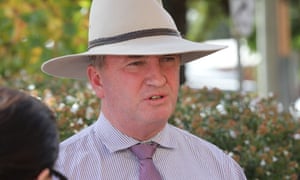Here we explain everything from overland flows to water buybacks and why they’re gripping the nation’s politics
What has happened?
Barnaby Joyce is under fire because of an $80m deal he approved as water minister in 2017. The company that received the payment, Eastern Australia Agriculture (EAA), booked a $52m profit on the deal, much of which appears to have been transferred to its parent company in the Cayman Islands.That company was co-founded by the energy minister, Angus Taylor, who has stated that he has no current involvement in the company and has received no benefit.
If the deal was in 2017 why is this big now?
Good question. The Guardian wrote about the deal in early March 2018 and The Australia Institute published a detailed report about the same time. This story coincided with Joyce’s downfall and it seems the Australian public can only handle one Barnaby scandal at a time.The scandal got a reboot once it was named #watergate (boom-tish) and widely shared in a Twitter thread that brought Taylor into the centre of the story. The deal was again written about in the Guardian and was dissected in a segment on The Project, while Taylor threatening to sue the tweeters propelled the story further. Its re-emergence during the federal election campaign also helped push the story to the front pages.
So what is a water buyback?
Too much water is taken out of the Murray-Darling Basin for irrigation, as one million dead fish and towns with no water have demonstrated. The water is legally owned by irrigators and other water users and so governments have been buying some of this water back to restore the health of the river system.Sounds simple. Aside from the price tag and the Joyce Caymans thing, what’s the problem here?
When we say irrigators “own water”, what we mean is that they own the right to use an amount of water each year. Sometimes there’s not enough water for users to get all they’re legally entitled to. Sometimes there’s none.In particular, the Watergate deal relates to flood water. In the Condamine Balonne region where the deal took place, it is very flat. So when it does rain it floods easily. As flood water crosses farms some of them divert this water with levee banks and pump it into huge dams (see video) to be used in years to come.
The first problem is that it appears the Watergate water can’t physically get off the EAA property. The levee banks that catch the water seem to be still in place and the government has not been able to provide any evidence they have been removed.
The next problem is that the Watergate deal appears to have paid a large amount for the water, but no dam. So when it does exist it can’t be stored and used later when the environment might need it. Whoops.
Worse still, this particular kind of water right, an “overland flow licence”, only legally exists on the property. If the water is allowed to physically leave the properties, it is no longer owned by the commonwealth and there is nothing to prevent other properties legally sucking up the water that the taxpayer just bought, like cotton farm Cubbie Station, which is just downstream.
OK, so we paid $80m for water we can’t really rely on. It can’t get any worse, can it?
You’re new here, aren’t you?!There were several of these “strategic buybacks” during Joyce’s time as water minister.
Another was just near Menindee, where the fish kills were. One large agribusiness, Webster Limited, chaired by the businessman Chris Corrigan, received nearly $80m for its water rights and also booked a $36m profit on this sale. Part of this deal was $40m in compensation for loss of future business. The company then scored a gift of water for a $35m cotton crop.
No other business in the Lower Darling/Barka region has received a deal like this. This is like selling your car for $10,000 and getting another $10,000 to cover future taxi fares.
The Menindee deal is tied up in a batch of deals relating to a taxpayer-funded pipeline to Broken Hill and a “water savings project” that have implications for irrigation, Broken Hill town water and mining projects. These deals are, to say the least, controversial.
Another strategic purchase was in the Warrego River, Queensland, which meets the Darling/Barka near Bourke, NSW. In 2008 Joyce criticised Labor for buying water here because it doesn’t reliably meet the Darling. In 2017, he did exactly the same thing, just at twice the price per megalitre.
Another buyback was in the Murrumbidgee and will be the subject of a future Australia Institute report.
What’s the takeaway message here?
The key point is that the Murray-Darling system is being hopelessly mismanaged and is deeply politicised. But it’s not political in the usual ways of left-right, environment v farming, or upstream v downstream politics.Instead, it’s about the powerful and the well-connected against everyone else – communities, smaller farmers, fish, frogs, ducks and the rest of the environment. All these deals are legal, they’re just not good deals for taxpayers or the environment.
The point is that businesses that are well-connected are doing well while everyone else, including the environment, is not. While nothing less than a royal commission will get to the bottom of all the problems, we also need real improvement in the Murray-Darling, which will take a range of reforms that will only be possible with sustained political will. That will take Australians inside and outside of the basin paying attention to our greatest rivers and caring about what happens to them.
I’m actually a bit sceptical that this will happen. But if you’ve made it to the end of this article, we’re off to a good start.
• Maryanne Slattery is senior water researcher at The Australia Institute

No comments:
Post a Comment